Related Research Articles

Verona ( və-ROH-nə, Italian: [veˈroːna]; Venetian: Verona or Veròna, is a city on the Adige River in Veneto, Italy, with 258,031 inhabitants. It is one of the seven provincial capitals of the region. It is the largest city municipality in the region and the second largest in northeast Italy. The metropolitan area of Verona covers an area of 1,426 km2 and has a population of 714,310 inhabitants. It is one of the main tourist destinations in northern Italy because of its artistic heritage and several annual fairs and shows as well as the opera season in the Arena, an ancient Roman amphitheater.
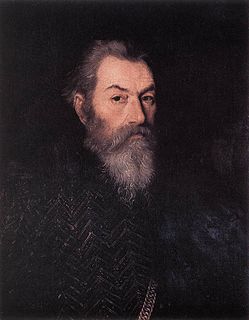
Paolo Farinati was an Italian painter of the Mannerist style, active in mainly in his native Verona, but also in Mantua and Venice.
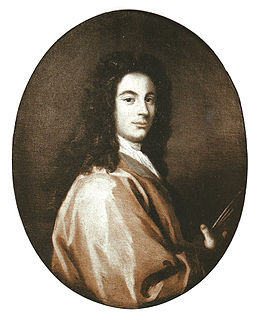
Antonio Balestra was an Italian painter of the Rococo period.

Marco Benefial was an Italian, proto-Neoclassical painter, mainly active in Rome. Benefial is best known for his repudiation of 18th century decorative Rococo styles pre-eminent in the Rome dominated by Carlo Maratta pupils. His paintings portrayed tangible human figures, with complex treatment of space, and luminous, warm colors. Along with the altarpieces and frescoes, he also painted many portraits. Because he partnered with some inferior artists who subsequently received credit, some of his paintings have been frequently misidentified.

Cesare da Sesto (1477–1523) was an Italian painter of the Renaissance active in Milan and elsewhere in Italy.

Giovanni da San Giovanni, also known as Giovanni Mannozzi, was an Italian painter of the early Baroque period.

Giacinto Gimignani was an Italian painter, active mainly in Rome, during the Baroque period. He was also an engraver in aquaforte.
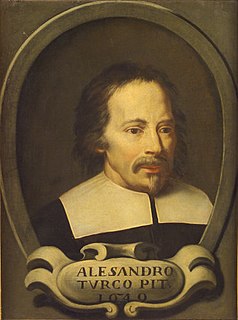
Alessandro Turchi was an Italian painter of the early Baroque, born and active mainly in Verona, and moving late in life to Rome. He also went by the name Alessandro Veronese or the nickname L'Orbetto. His style has been described as soft and Caravaggesque at the same time.

Santi Prunati was an Italian painter of the Baroque era, born and mainly active in Verona.
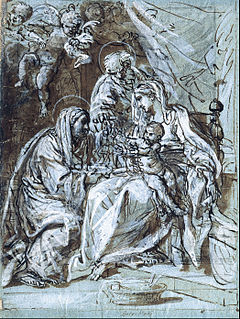
Niccolò Berrettoni was an Italian painter of the Baroque period.
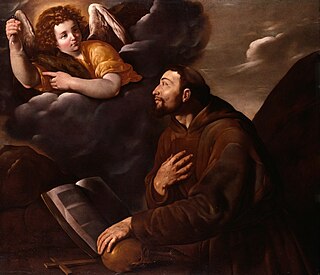
Pasquale Ottino or Ottini, was an Italian painter.

Francesco Torbido was an Italian painter of the Renaissance period, active mainly in Verona and Venice. He is also known as il Moro.

Verona Cathedral is a Roman Catholic cathedral in Verona, northern Italy, dedicated to the Blessed Virgin Mary under the designation Santa Maria Matricolare. It is the episcopal seat of the Diocese of Verona.
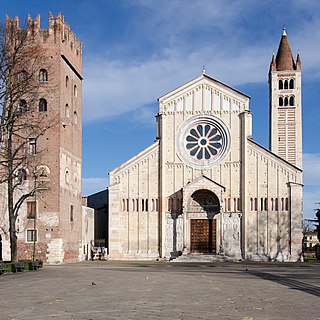
The Basilica di San Zeno is a minor basilica of Verona, Northern Italy constructed between 967 and 1398 AD. Its fame rests partly on its Romanesque architecture and partly upon the tradition that its crypt was the place of the marriage of Shakespeare's Romeo and Juliet. It stands adjacent to a Benedictine abbey, both dedicated to St Zeno of Verona.

Sant'Anastasia is a church of the Dominican Order in Verona, northern Italy. In Gothic style, it is located in the most ancient part of the city, near the Ponte Pietra.

San Bernardino is a church in Verona, northern Italy. The church, in Gothic style, was built from 1451 to 1466.
Michelangelo Spada was an Italian painter in Verona. He should not be confused with the 16th century Count Michelangelo Spada of Terni who was chamberlain of Pope Julius III.
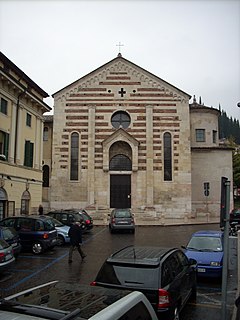
Santo Stefano is a Paleo-Christian, Roman Catholic basilica church in central Verona, region of Veneto, Italy.
Giovanni Battista Belloti was an Italian painter of the Baroque style, active mainly in Verona.
Paolo Zimengoli or Cimengoli was an Italian painter of the Baroque style, active in his native Verona and Bergamo.
References
- Bryan, Michael (1886). Robert Edmund Graves (ed.). Dictionary of Painters and Engravers, Biographical and Critical. Vol. I: A-K. London: George Bell and Sons. p. 33.
- ↑ Le vite de' pittori, degli scultori, et architetti veronesi, by Bartolomeo Dal Pozzo (1718), page 168-169.